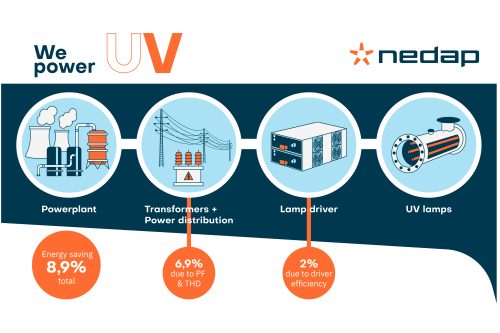Nedap is committed to the Science Based Targets initiative (SBTi). But what does this mean in practice? And what benefits does it offer our customers? In this article, we explain how our UV lamp driver technology contributes to the development of sustainable solutions.

Achieving sustainability goals is a key priority for water sector professionals, especially in the context of Scope 3 emissions and the Science Based Targets initiative (SBTi). For those specializing in UV treatment technologies, aligning with these targets may seem daunting. Reduce your ecological footprint with Nedap’s UV driver technology. Achieve sustainability goals without compromising on performance.
The SBTi methodology is designed to help businesses align their emissions reduction targets with climate science. It encourages companies to reduce their CO2 emissions in line with global efforts to limit warming to well below 2 degrees. Scope 3 emissions result from the value chain, including sold products. These emissions are often the most challenging to reduce. This is especially true for high-power electronics like UV technology used on an industrial scale.
Nedap’s commitment to reducing its Scope 3 emissions aligns with this framework. We commit to the SBTi economic intensity target by cutting emissions from the use of our products year-over-year per unit of economic value.


On an industrial scale, the operational phase of UV systems has the largest CO₂ impact over their lifecycle, driven by the energy required for continuous performance. It is crucial to optimize the duty cycle, the time a product is active. Energy consumption can be reduced through strategic portfolio choices and energy efficient components. Using smart functionality is another key factor. Managing these aspects helps improve efficiency, cut costs, and support sustainability goals.
Optimization 1: Strategic portfolio choices
Nedap makes strategic choices in selecting components for its drivers, aligning with its SBTi targets. These efficient components help lower energy use during the product’s lifecycle. Nedap’s solution is designed to optimize energy efficiency without compromising on performance. By integrating these drivers into your UV systems, you minimize environmental impact and reduce total cost of ownership.

Sustainability leaders are tasked with ensuring that products comply with strict environmental and electrical regulations. An important consideration is how electrical systems interact with the power grid. We often see systems that use electricity in a way that is not always best compatible with conventional power grids. This leads to additional energy losses in infrastructure such as transformers and power lines. By complying with standards for harmonic distortion and ensuring minimal energy loss, businesses can enhance both operational efficiency and sustainability. Nedap’s drivers not only help meet regulatory requirements but also align with industry best practices, providing a reliable and energy-efficient solution for the future.
Infographic: By using high-quality lamp drivers with high Power Factor (0,99) and low Total Harmonic Distortion (THD) of 5%, you can achieve up to 9% electrical energy savings.

Looking ahead, the integration of AI technology in the water sector will play a critical role in making UV systems even more efficient. In the future, Nedap’s smart driver platforms could for example be enhanced with AI systems that automatically respond to changing water quality or consumption patterns. These intelligent UV systems would be able to dim or adjust lamp output in real-time, optimizing energy use during periods of lower demand. This would allow businesses to reduce operational costs and further decrease their carbon footprint. While this technology is still evolving, it holds the potential to help companies not only meet their Scope 3 goals but also remain adaptive and competitive in a rapidly changing market.

“Reducing emissions doesn’t just benefit the environment; it also makes sound economic sense. By lowering the energy consumption of your UV systems, you can significantly reduce lifecycle costs. This presents an opportunity to balance performance with sustainability while enhancing a competitive edge in the market.”

Nedap’s UV driver technology is more than just an upgrade to your water treatment systems; it’s a vital tool in achieving Scope 3 emissions reductions. This technology aligns with the SBTi methodology and helps your company achieve sustainability goals. Improve energy efficiency, meet future regulations, and enjoy economic and environmental benefits. Start integrating these solutions today for a cleaner, greener future for your business and the planet.




